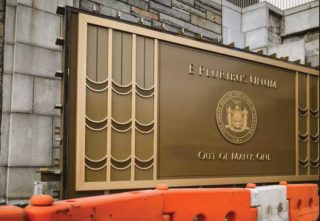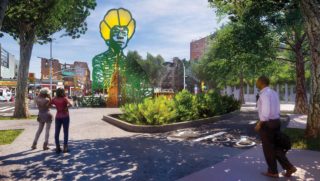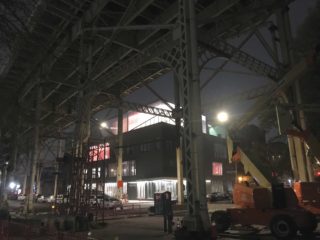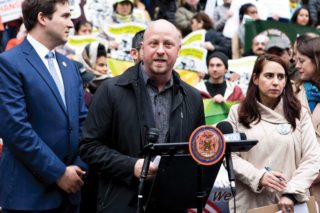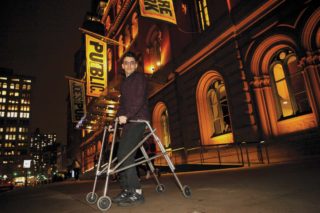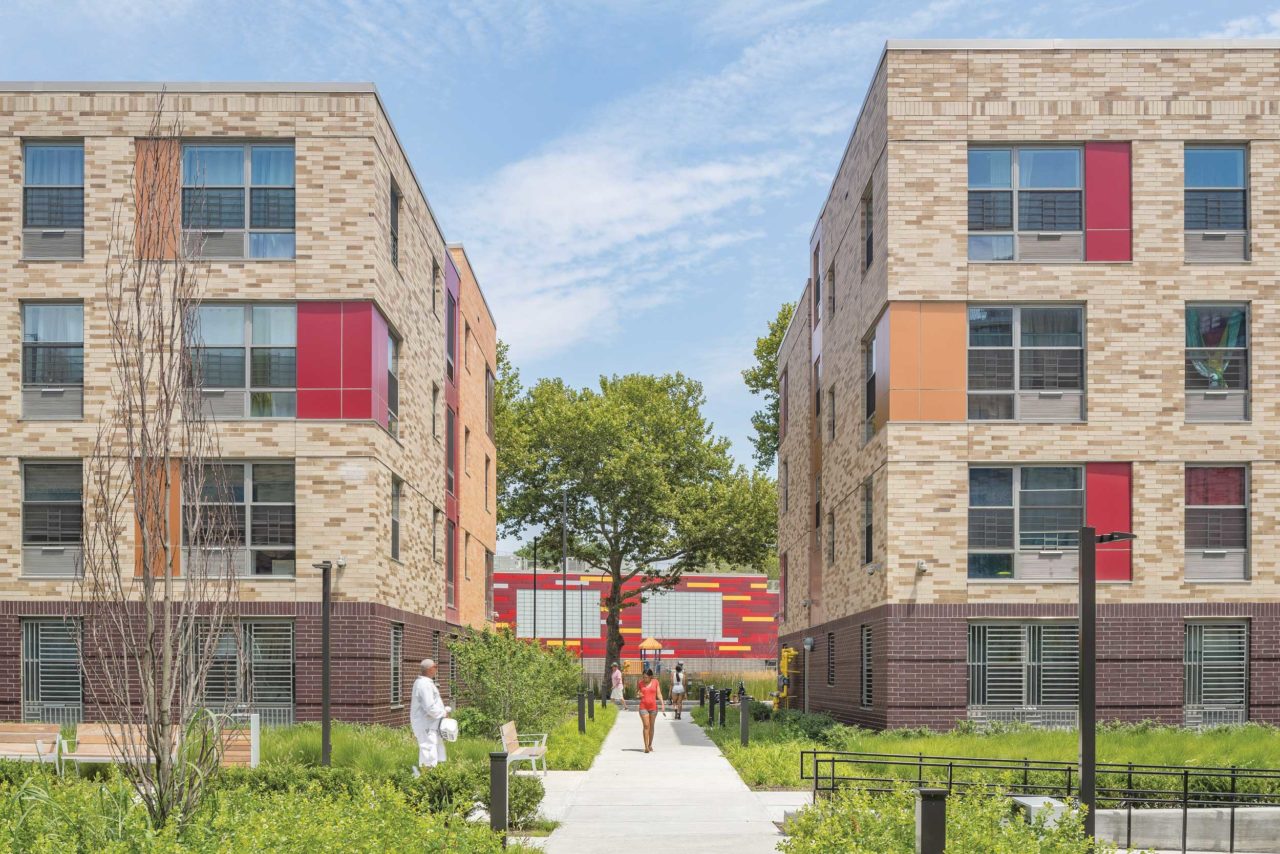
New York is experiencing an extreme housing market and policy failure, with the majority of residents fundamentally housing insecure. Almost 63% of New Yorkers are renters, according to the U.S. Census Bureau, and the highest proportion are under 50 years old. The median income for an individual in the city is nearly $58,000, meaning half of New York City adults make less. Few apartments are available for under $1,500 in the open market, yet to rent a $1,500 studio, leaseholders are expected to be earning $60,000, based on the traditional metric of income being 40 times the monthly rent. By this measure, the market is failing to meet the needs of more than half of individual wage earners.
The market is only marginally better for two-income households: Two-bedroom apartments for $2,500 and up are more readily available, but lessees must earn $50,000 each unless backed by a cosigner. Since a full-time minimum wage job brings in only $31,000, the market excludes all but the most secure middle-class wage earners. No wonder New Yorkers are up in arms about high-end condo and office park developments: the most basic need for shelter is being neglected. Imagine if a housing policy were designed to meet the needs of the largest number of New Yorkers. It would produce apartments of an adequate size for every household type that would be well designed, promote health and well-being, conserve energy, and, above all, be affordable for most residents. Here are 10 proven, immediately implementable policies that would remediate the market-and-policy failure:
1. Expand Rent Stabilization
The danger of rent control, we are often reminded, is that landlords might earn less than it costs to maintain buildings, resulting in widespread abandonment. A search of public records on any given rent-stabilized building, however, indicates that landlords typically walk away with hundreds of thousands of dollars in annual income—with little to no effort. Currently, nearly a million New York City apartments—almost half the city’s rental units—are relatively affordable and secure from inflationary rent increases due to rent stabilization and control. With the city’s average household size of 2.67, that means nearly a third of New Yorkers may be protected by rent regulation.
“Do I wish New York State’s rent control laws were tougher?” said a former high-level official of the De Blasio Administration. “Yes, I do. Rent stabilization is not the most equitable system, but it does protect a lot of people. And the number is declining because we don’t have as strict rent-control/rent stabilization laws as we should. But the city’s ability to do anything in that area is largely preempted by the state.”
The simplest policy solution available to lawmakers—now being considered in Albany and advocated by the Housing Justice for All coalition—is the expansion of rent-stabilization guidelines to include more units. As smaller buildings increasingly come under the control of speculators and larger landlords, the coalition is proposing a “good cause” eviction law that would give tenants in buildings of less than six units the right to renew leases at limited rent increases, while strengthening protections for existing rent-stabilized tenants.
Rent stabilization can also involve eligibility guidelines like the ones NYC Housing Preservation & Development (HPD) already use to allocate new units. The current package of bills allows rent increases for building improvements, but limits them to prevent exploitation by unscrupulous landlords. “We must have strong rent protections to ensure that individuals aren’t priced out or pushed out by landlords,” said New York State Assemblyman Joseph Lentol. “We just passed a bill that criminalizes landlord harassment behavior, which will be a deterrent to forcing families out of rent-stabilized housing.”
2. Publicly Fund Social Housing
In 1975, the city’s short-term bonds to build affordable housing nearly bankrupted the city. Eleven years later, the federal government prohibited federal money from being used to build public housing, substituting a fragmentary system of grants and tax incentives to private and non-profit developers. This has resulted in the failed housing marketplace of today. Despite that, the NYC Housing Authority still shelters nearly 400,000 residents—one in 14 New Yorkers—and another 200,000 receive Section 8 housing vouchers. More than 200,000 are on waiting lists for public housing and nearly 150,000 for Section 8 housing.
“New York needs to follow the lead of London, where boroughs like Hackney have started building public housing for the first time in four decades,” noted urban planner and housing specialist Karen Kubey. “New public or ‘social’ housing projects there, designed by Karakusevic Carson Architects and others, are built to high design standards and meaningfully involve residents during the design process. Developments are typically cross-subsidized with market-rate housing. Doing this would require policy shifts, but if our sister financial capital can do it, why can’t we?”
“Housing should be a human right,” said Lentol, “and the federal government should be spending more money on housing than on building multimillion-dollar concrete walls.
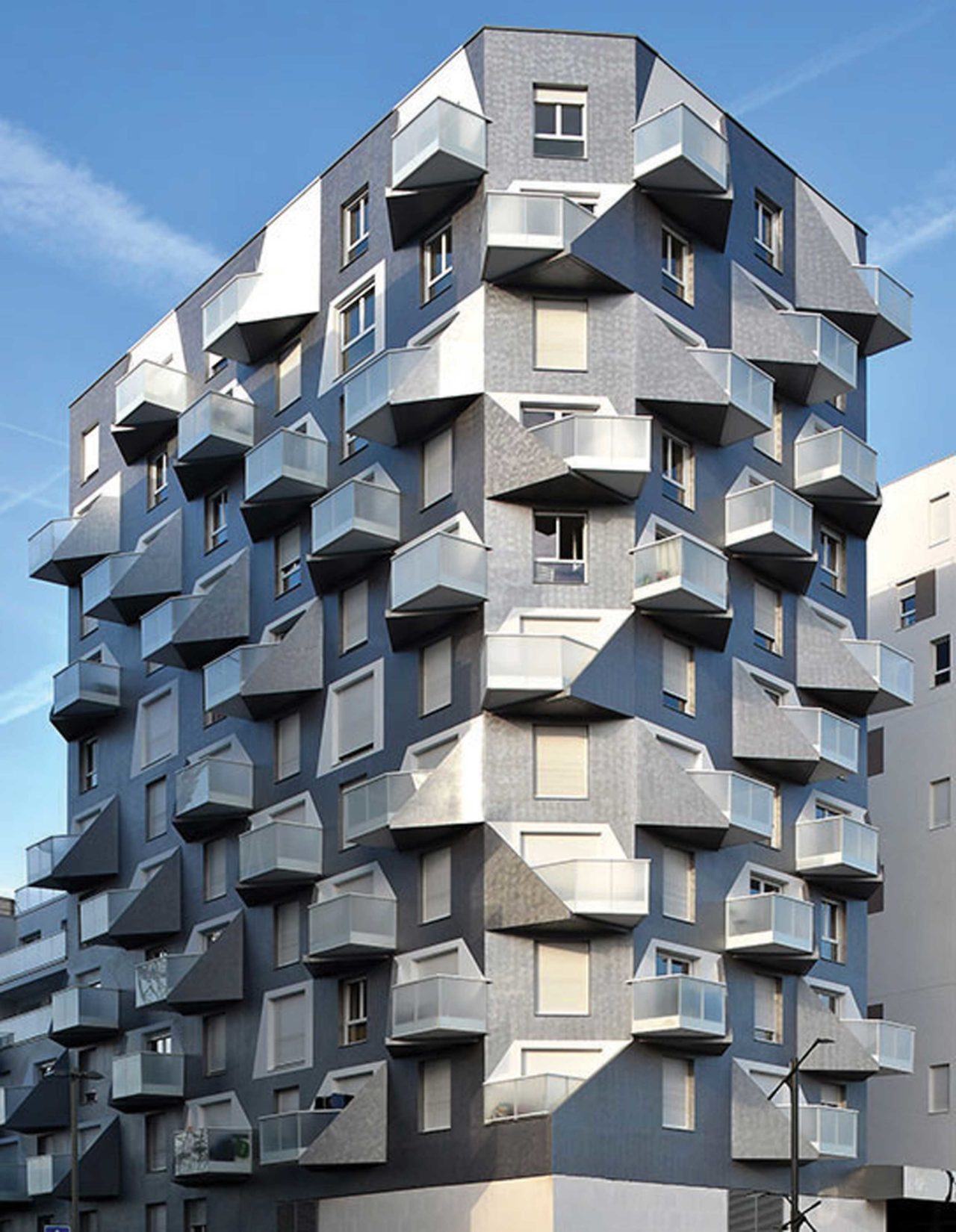

3. Use Public Banking
Even if the federal government refuses to provide funding, the city and state governments still can. They can issue state and municipal bonds and establish public banking institutions, using city and state tax revenues to issue long-term, low-interest loans to non-profit developers for housing and infrastructure projects, recycling the profits toward additional public investments. “As new tax money is garnered from platform-style companies,” said Lentol, “it should go to programs that allow localities and not-for-profits to build.”
Public banking is a model we can learn from French social housing providers like Paris Habitat, which for more than a century has been building social housing using loans from the Caisse des Depots. “All this money is dedicated to funding what the country needs to develop its activities,” said Bertrand Bret, advisor to the chairman of Paris Habitat. “It means harbor, airport, speedway, economic development of the cities, tourism, and social housing.” A recent exhibition curated by Javier Arpa at the Pavillon de l’Arsenal showcased 100 years of Paris Habitat’s projects, including work by Hariri & Hariri Architecture, Brenac & Gonzalez, Béal & Blanckaert, Sou Fujimoto Architects, and MAD that is indistinguishable from the highest quality luxury housing in New York City.
Keith Engel, AIA, a senior associate at Dattner Architects, long known for its affordable housing specialization, points out that existing laws place limits on the amount of debt the city and state are allowed to take on. “There’s a finite amount of subsidy that comes into the city, and that’s been shrinking,” Engel said. “A lot of projects sitting in architects’ offices aren’t moving forward because the closings can’t happen as there’s just not enough funding.” In the meantime, Dattner has focused on raising the sustainability standards of its projects, incorporating passive housing techniques in non-profit developments financed by HPD, including 425 Grand Concourse, a 277-unit development in Mott Haven projected for 2020; Chestnut Commons, a 275-unit passive house with community center, expected by 2022; and 1675 Westchester, 220 units on a rezoned lot in Soundview.
4. Implement First Right to Buy
Many architects and city officials cite the limited availability of land and competition with for-profit developers for sites as key factors impeding more low- to moderate-income developments. Even the costs of acquiring brownfield sites are now being inflated by competition with traditional developers. Bret cites the ability of public agencies to get a right of first refusal for the purchase of developable land and apartments, which it then offers to qualifying applicants at preferential rents scaled to each household’s income.
“It is what is called the ‘preemptive right’—the right to buy first,” Bret said. “If you want to buy a flat, a building, or a garage, you have to get the agreement of the local authority. Each week, a dedicated committee checks what is put on the market, and according to the location, the local authority can say, ‘I want this for an extant school, I want this for building a new swimming pool, I want this to create social housing, and I put my right to buy first.’ And there is a discussion between the seller and the local authority to fix the good price.”
5. Build On Underused and Unusual Sites
Another strategy to alleviate the housing crisis is to privilege the use of public land. Steps in the right direction include initiatives like the Big Ideas for Small Lots competition, a collaboration with the AIA New York Chapter that thinks of innovative ways of developing unusual sites; the De Blasio Administration’s Mandatory Inclusionary Housing policy for rezoned districts; the NextGen program to build new housing on NYC Housing Authority property; and projects like Hunters Point South and the Essex Market/Seward Park Urban Renewal Area.
“The challenge in New York is we’re in an expensive, high-density environment,” said Jay Valgora, AIA, principal of Studio V Architecture. “Much of the city is already built.” Valgora believes waterfronts, urban renewal sites, and public housing “are huge opportunities to actually realize the goal of creating much more affordable housing.”
Critics point out that the affordability targets are often too high to qualify for, and the number of units is usually conservative, erring on the side of ensuring that developers can reap profits by allowing a greater percentage of market-rate housing. Both Dattner and Studio V have developed projects in NYCHA’s Astoria Houses at Halletts Point, which will eventually comprise 2,400 apartments. An HPD spokesman mentions the recently announced latest phase of the Hunters Point South project as another model: Designed by ODA New York, it will include 1,100 new units, 60% of them permanently affordable, along with 100 units of supportive housing for seniors.
6. Mandate Social Housing in Every Neighborhood
The adoption of policies that more equitably allocate housing to create a mixture of incomes throughout the city goes to the heart of the integral relationship between housing and inclusion in NYC. Eran Chen, AIA, founder and executive director of ODA, believes that mixed-income projects like Hunters Point South should be a mandatory model for every neighborhood and large building.
“The only good long-term solution is in full integration of a certain percentage of affordable housing components in most buildings above a certain scale,” noted Chen. “To do so, policies should incentivize builders and developers with increased density/height bonuses for new construction and real estate tax reductions for existing rental buildings. Affordable units need to be built on-site, be applicable in wider areas in the city, and be incorporated into existing buildings. A majority of buildings should have an affordable component well mixed and equally distributed in such a way that landlords and developers will not encounter financial hardship.”
Vishaan Chakrabarti, former Manhattan city planner and principal of Practice for Architecture + Urbanism, points out that the biggest impediments to expanding and improving the homeless shelter system is the local opposition that occurs whenever a new shelter is announced. He recommends “mandatory fair share for homelessness housing, where we pass a law that says there have to be a certain number of units in every Community Board in NYC.”
7. Tax Vacant Land and Apartments
In New York, owners currently get a tax break if they don’t live in their apartments as a primary residence. A policy meant to spur investment, this incentive pushes the market toward upper-income condos rather than meeting the needs of residents. The City Council has already considered a version of a pied-à-terre tax on vacant apartments, which could encourage people with investment property to rent it and generate revenue for construction of social housing. This has been done successfully in Vancouver, British Columbia, with some positive impact on lowering prices, and Paris has a similar tax to discourage absentee owners. By one estimate, there may be 50,000 units of vacant apartments in the city, though the former De Blasio official believes many are being rented.
Chakrabarti further recommends taxing vacant land to discourage real estate companies from land banking—holding on to lots without building. “We’re not generating enough supply of any housing, market rate housing or affordable housing, to keep up with demand, which is continually pushing up demand for market rate housing. A lot of that has to do with people land banking,” he said. “We must look at whether we need to more heavily tax vacant land, so owners have much more incentive to build.”
Chakrabarti further recommends taxing vacant land to discourage real estate companies from land banking—holding on to lots without building. “We’re not generating enough supply of any housing, market rate housing or affordable housing, to keep up with demand, which is continually pushing up demand for market rate housing. A lot of that has to do with people land banking,” he said. “We must look at whether we need to more heavily tax vacant land, so owners have much more incentive to build.”
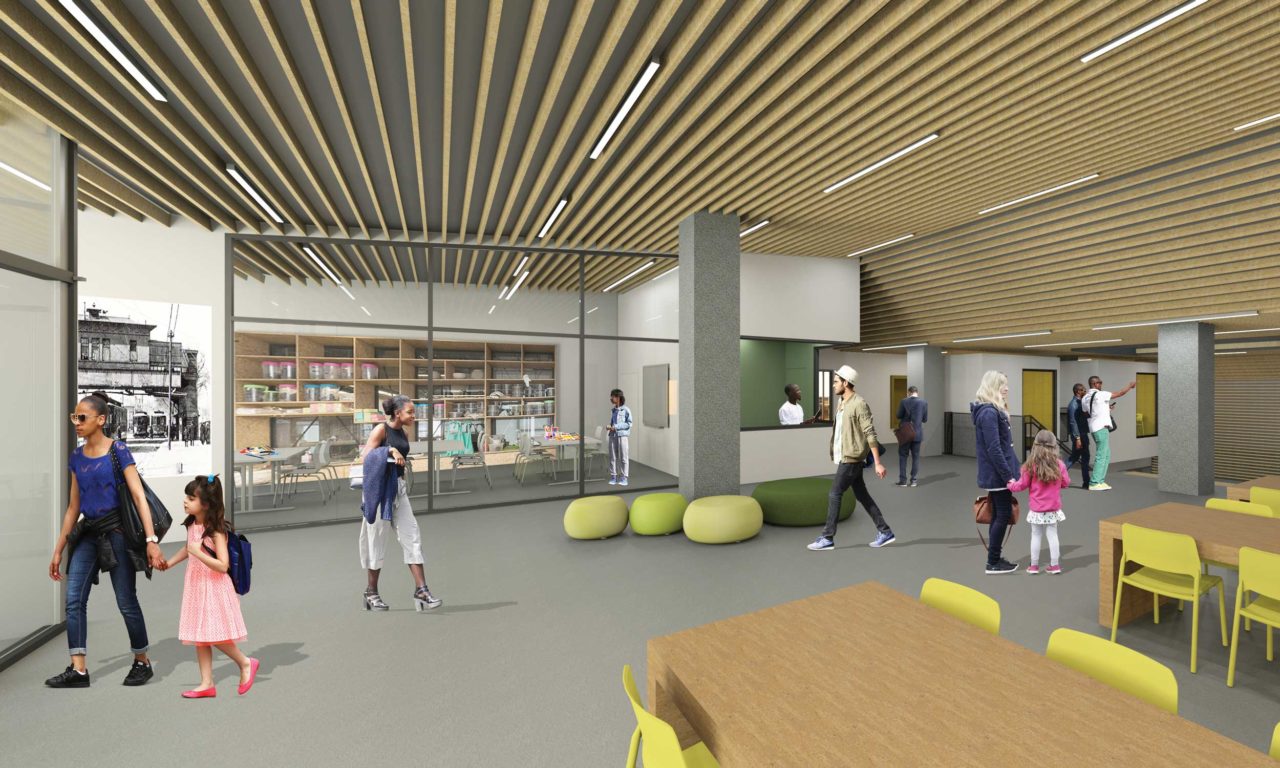
8. Consider Alternative Housing
The HPD is looking into alternative and unorthodox housing types to meet the needs of populations not being served by the market. The Basement Conversion Pilot Program attempts to legalize rentals in basements that might not meet all the narrow coding regulations for window height, air, ceiling height, and fire safety but have potential to be regularized.
Another under-the-radar housing type are single-room occupancy (SRO) units, which the HPD and Engel believe can meet the needs of younger people, older people aging in place, and residents open to cohabiting. Last November, the NYC department of Housing Preservation and Development issued an RFP for ShareNYC, seeking development teams to arrive at design guidelines for SROs that improve on the Bowery flophouse of old. Valgora mentions Frank 57 at 600 West 58th Street as an example of experiments with co-living: The project includes 12 co-living units with shared bathrooms, but the market being the market, these are actually being leased for even more than the standard units in the development.
9. Review All Tax Structures
One of the biggest underlying conditions that makes housing unaffordable is the whole suite of city, state, and federal tax incentives meant to promote housing construction, dating back to a period of a lack of investment in the city. They include the federal mortgage interest deduction, the state 421-A deduction, the J-51 abatement for renovating apartment buildings, and the co-op and condo deduction. All these tax structures need to be reviewed and geared toward promoting affordable housing.
10. Upzone
Only with these policies in place would it make sense to do more of what the Bloomberg and De Blasio administrations have already done: strategically upzone areas where there’s room for expansion of building heights without destroying the character of neighborhoods. “You’ve got to start with the basic evidence that the new destabilizes the old,” Chakrabarti said. “All this business about area median income and affordable housing creation works only if you have very significant policies in place to stabilize existing neighborhoods.”
Since 2000, notes Bertrand Bret, Paris has gone from 11% to 22% of its apartments being regulated as social housing, with a goal of reaching 25% by 2025. Meanwhile in New York, since 1981, there are 200,000 fewer regulated apartments and twice as many homeless people. It’s time to reverse course—quickly.









